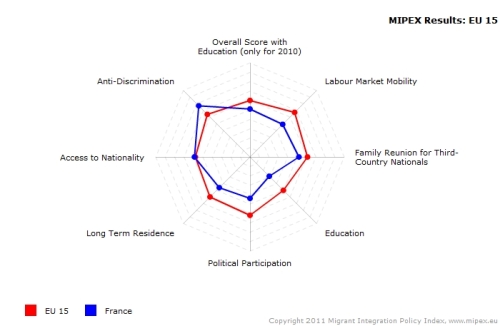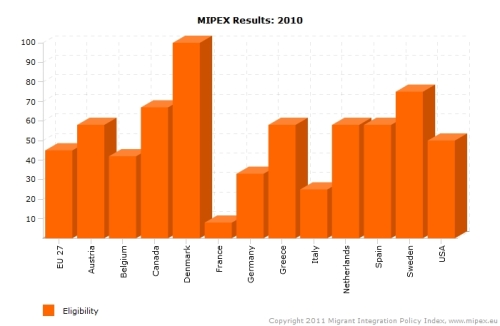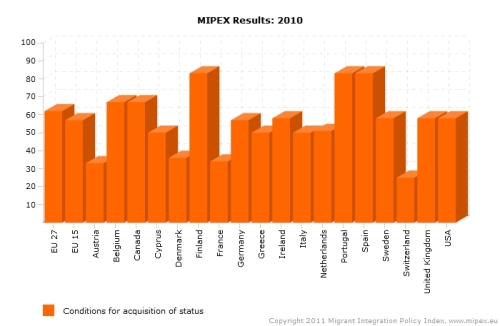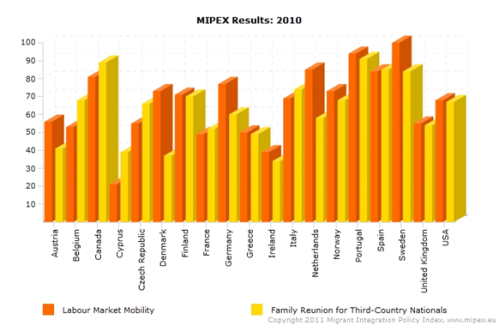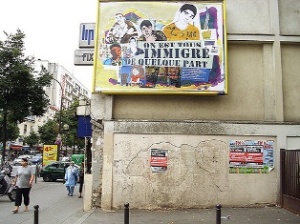 Written by Thomas Huddleston, MIPEX Research Coordinator, Co-author and Policy Analyst, Migration Policy Group
Written by Thomas Huddleston, MIPEX Research Coordinator, Co-author and Policy Analyst, Migration Policy Group
Last week, I presented the MIPEX results for France, a country pushed in opposite directions. Overall, France scores 51 out of 100, which is 1 point below the EU average, and ranks 15th, which puts it behind Canada, Spain, the United States, Italy, Germany, the United Kingdom, even Denmark.
While anti-discrimination laws in France and across Europe continue to improve because of EU law, the French government’s main preoccupation has been with minor changes on the same limited issues like conditions for family reunion. The 2007 Hortefeux Law is one of many ‘immigration reforms’ (the 4th in 7 years, with a 5th now under debate). I illustrated my key points with new charts and graphs. I generated them through “Play with the Data” just like any website user can.
I compared France to the EU-15, that represent Europe’s established countries of immigration. France currently leads on anti-discrimination and equality policies, so far. Plans to replace the Equality Body—la HALDE—may create a body without the same power and independence to effectively assist victims, while past and future laws can strip away current protections against nationality discrimination, which lay outside the scope of EU law. Becoming a citizen emerges as no easier in France than in most EU-15 countries, despite what many French policymakers assume. France only ranks 9th on Access to Nationality because French prefects enjoy significant discretion when conducting the procedure and evaluating the conditions for acquisition. In all other areas, France scores below its average peer country:
Long-term residence
Fewer and fewer categories of immigrants can access long-term residence. Twenty years ago, long-term residence was the rule rather than the exception which encourages immigrants to settle and invest in integration. The 2003 and 2006 reforms shrunk the list of who can apply and made France fall beyond most other European countries on eligibility for long-term residence:
Family reunion
French president Sarkozy has claimed that France has the most liberal family reunion policies in Europe, because the 2007 Hortefeux Law only proposed restrictive conditions that were average for most countries. In a MIPEX prospective impact assessment, I argue that the French Presidency’s European Pact on Immigration and Asylum also gave the impression that EU Member States were harmonising around France’s recent legislation, which served as the model for the Pact’s text on family reunion. Fact-checking these claims, I find that few EU Member States follow France:
Most countries require some conditions such as basic housing or income; France requires both, plus integration and pre-departure requirements, plus continually higher levels. These restrictive conditions only compare with Austria, Denmark, and Switzerland. The finding reminded me a quote in Le Monde by Virginie Guiraudon—French immigration researcher at CNRS—during the 2007 MIPEX II event: “Etre à égalité dans ce domaine avec l’Autriche n’est pas a priori glorieux vu les développements politiques récents dans ce pays..[la France et l’Autriche] sont deux pays où il y a eu énormément de politisation [de l’immigration].”
Labour market mobility
Despite government promises to work on labour market integration, non-EU immigrants are still excluded from an estimated 7 million jobs, thanks to legislation dating back to the 19th century and the 1930s. Because of their nationality or degree, many qualified immigrants cannot accept many jobs in the public sector, 50 professions in the private sector (from pilots to tobacco shop owners) and self-employment in many regulated professions, from lawyers and doctors to architects and pharmacists. For more, see an excellent summary from GISTI–Groupe d’information et de soutien des immigrés. France’s Equality Body found no justification for this unequal treatment and recommended their appeals in most areas. Recently, the Senate unanimously approved lifting some restrictions, but the National Assembly majority refused, with claims that all countries had these restrictions. But as this chart clearly shows, migrant workers from outside the EU are denied legal access to more jobs in France than in all MIPEX countries:
Immigration subie vs. Immigration choisie?
Because MIPEX compares different policy areas, we have looked for strong positive statistical correlations. Most countries that do well (or poorly) in one area of integration do well (or poorly) in the others. President Sarkozy has claimed that countries either encourage work migration (“immigration choisie”) or they accept non-discretionary family or humanitarian migration (“immigration subie”). The President presented statistics in such a way that it seemed Canada mostly selects migrant workers while France mostly receives family migrants. This assumed trade-off runs throughout many of his government’s legislative proposals.
Testing this hypothesis, MIPEX finds little support for the opposition between immigration subie and immigration choisie…bien au contraire! Immigrant families are better able to reunite and participate in countries that help all newcomers find the right jobs. The countries that lead on both labour market mobility and family reunion are often countries of labour migration in Southern Europe and North America. In fact, Canada and the US attract high numbers of both migrant workers and their families. The graph below compares the scores on the two strands:
Two outliers here are clearly Denmark and The Netherlands, whose legislation removes obstacles for non-EU migrants to work but creates more for their families to reunite. Most countries with restrictive family reunion conditions like France often retain protectionist labour market measures. Put together, policies in France may risk creating in the long-term both social and economic exclusion.

